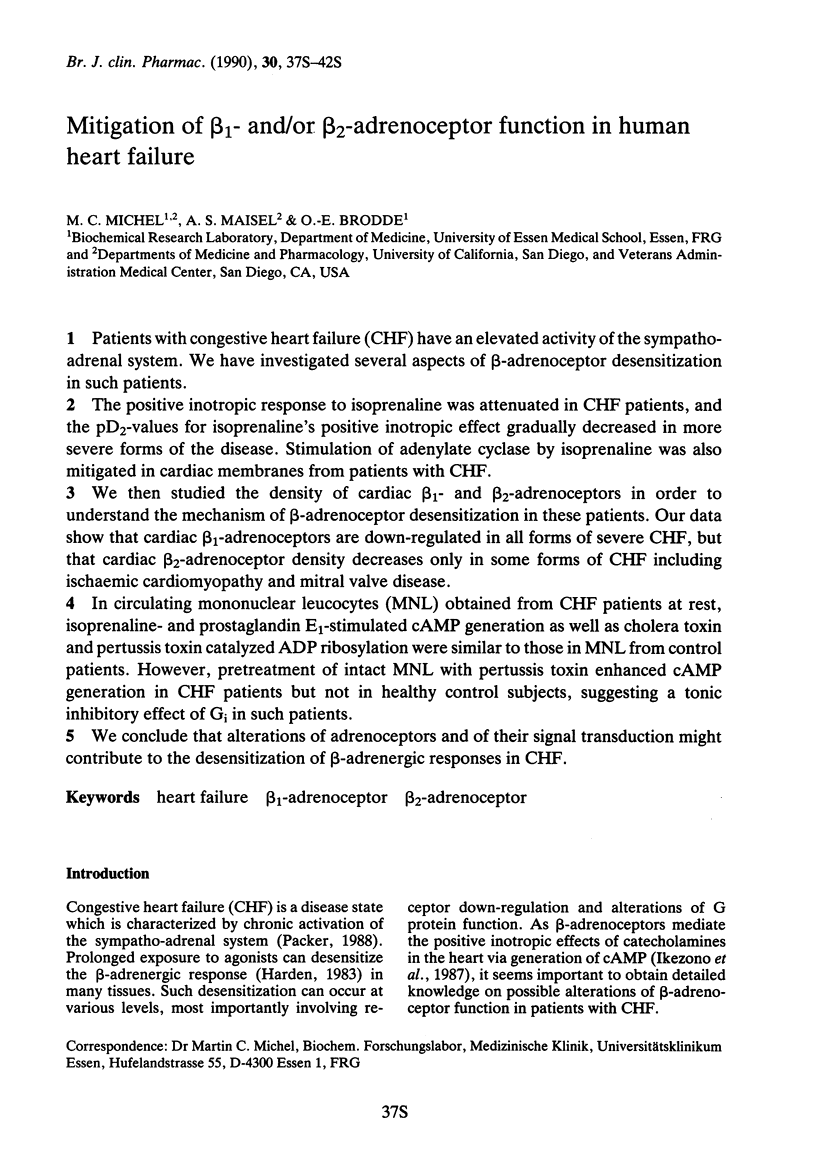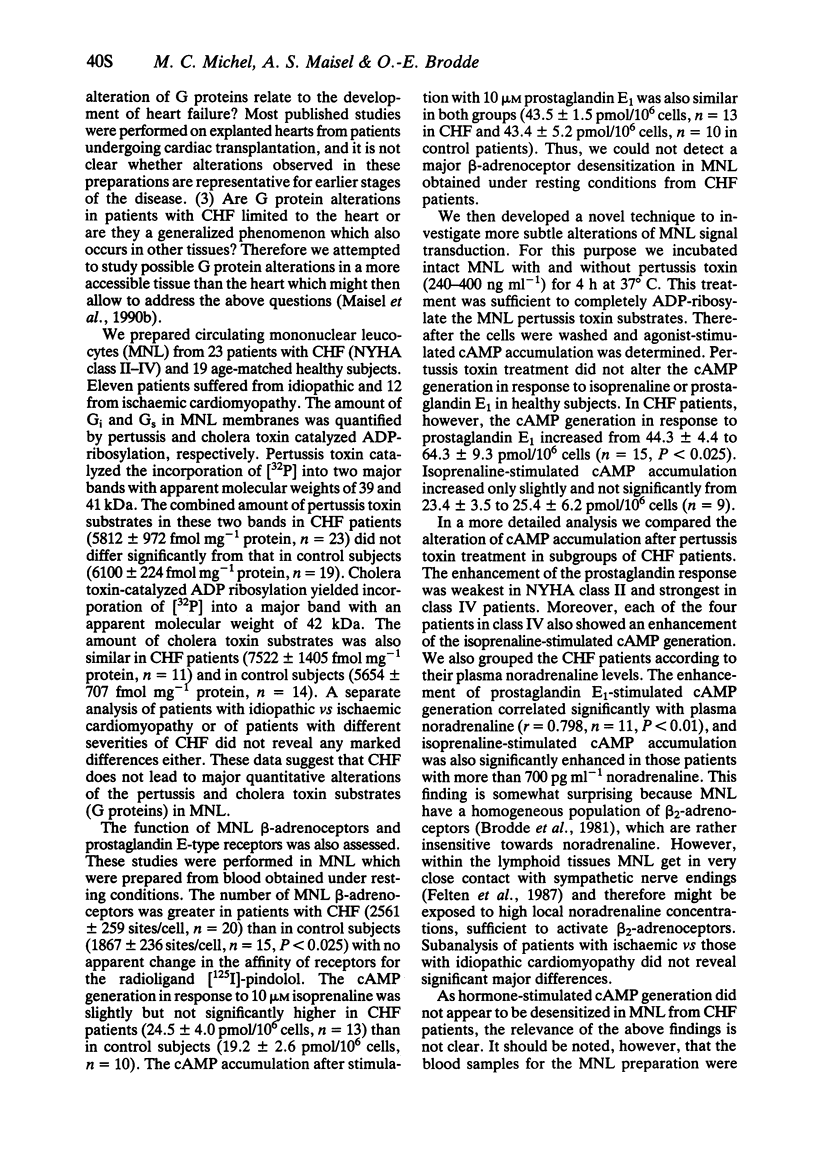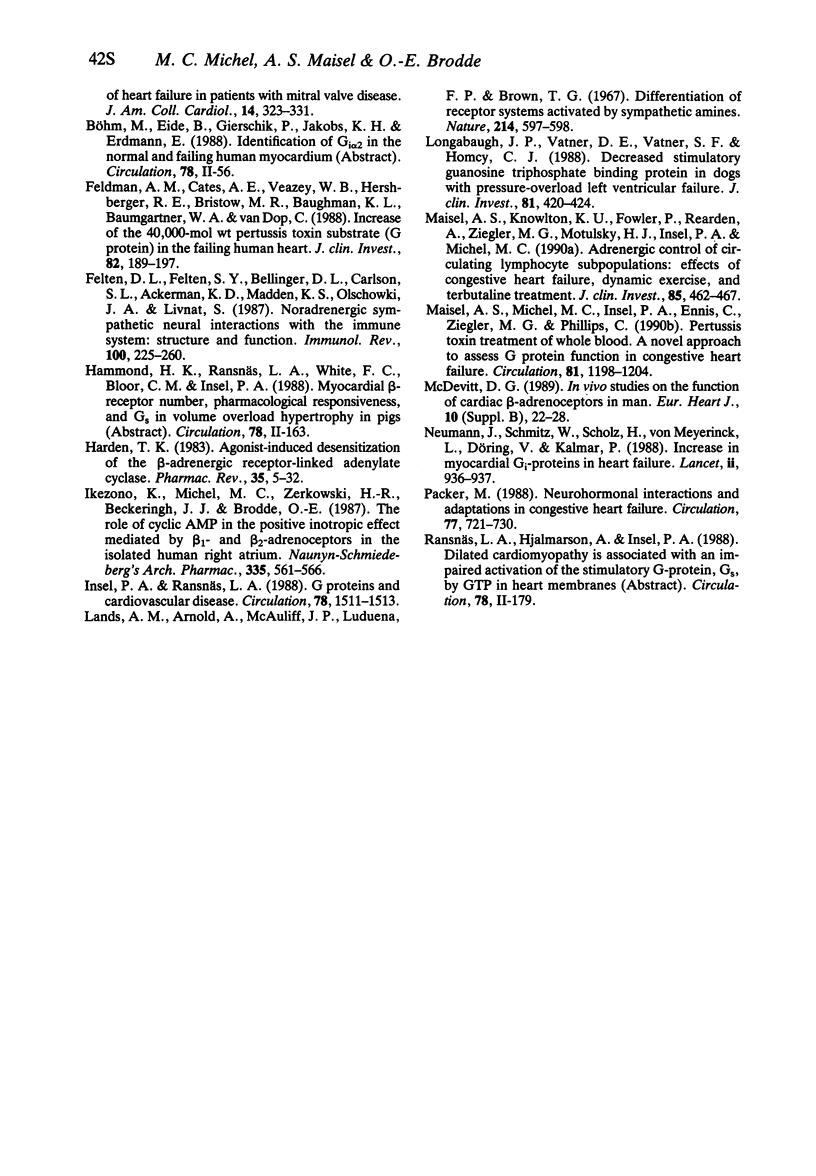Abstract
1 Patients with congestive heart failure (CHF) have an elevated activity of the sympatho-adrenal system. We have investigated several aspects of β-adrenoceptor desensitization in such patients.
2 The positive inotropic response to isoprenaline was attenuated in CHF patients, and the pD2-values for isoprenaline's positive inotropic effect gradually decreased in more severe forms of the disease. Stimulation of adenylate cyclase by isoprenaline was also mitigated in cardiac membranes from patients with CHF.
3 We then studied the density of cardiac β1- and β2-adrenoceptors in order to understand the mechanism of β-adrenoceptor desensitization in these patients. Our data show that cardiac β1-adrenoceptors are down-regulated in all forms of severe CHF, but that cardiac β2-adrenoceptor density decreases only in some forms of CHF including ischaemic cardiomyopathy and mitral valve disease.
4 In circulating mononuclear leucocytes (MNL) obtained from CHF patients at rest, isoprenaline- and prostaglandin E1-stimulated cAMP generation as well as cholera toxin and pertussis toxin catalyzed ADP ribosylation were similar to those in MNL from control patients. However, pretreatment of intact MNL with pertussis toxin enhanced cAMP generation in CHF patients but not in healthy control subjects, suggesting a tonic inhibitory effect of Gi in such patients.
5 We conclude that alterations of adrenoceptors and of their signal transduction might contribute to the desensitization of β-adrenergic responses in CHF.
Keywords: heart failure, β1-adrenoceptor, β2-adrenoceptor
Full text
PDF





Selected References
These references are in PubMed. This may not be the complete list of references from this article.
- Bristow M. R., Ginsburg R., Minobe W., Cubicciotti R. S., Sageman W. S., Lurie K., Billingham M. E., Harrison D. C., Stinson E. B. Decreased catecholamine sensitivity and beta-adrenergic-receptor density in failing human hearts. N Engl J Med. 1982 Jul 22;307(4):205–211. doi: 10.1056/NEJM198207223070401. [DOI] [PubMed] [Google Scholar]
- Bristow M. R., Ginsburg R., Umans V., Fowler M., Minobe W., Rasmussen R., Zera P., Menlove R., Shah P., Jamieson S. Beta 1- and beta 2-adrenergic-receptor subpopulations in nonfailing and failing human ventricular myocardium: coupling of both receptor subtypes to muscle contraction and selective beta 1-receptor down-regulation in heart failure. Circ Res. 1986 Sep;59(3):297–309. doi: 10.1161/01.res.59.3.297. [DOI] [PubMed] [Google Scholar]
- Brodde O. E., Daul A., Wellstein A., Palm D., Michel M. C., Beckeringh J. J. Differentiation of beta 1- and beta 2-adrenoceptor-mediated effects in humans. Am J Physiol. 1988 Feb;254(2 Pt 2):H199–H206. doi: 10.1152/ajpheart.1988.254.2.H199. [DOI] [PubMed] [Google Scholar]
- Brodde O. E., Engel G., Hoyer D., Bock K. D., Weber F. The beta-adrenergic receptor in human lymphocytes: subclassification by the use of a new radio-ligand, (+/-)-125 Iodocyanopindolol. Life Sci. 1981 Nov 23;29(21):2189–2198. doi: 10.1016/0024-3205(81)90490-2. [DOI] [PubMed] [Google Scholar]
- Brodde O. E., Schüler S., Kretsch R., Brinkmann M., Borst H. G., Hetzer R., Reidemeister J. C., Warnecke H., Zerkowski H. R. Regional distribution of beta-adrenoceptors in the human heart: coexistence of functional beta 1- and beta 2-adrenoceptors in both atria and ventricles in severe congestive cardiomyopathy. J Cardiovasc Pharmacol. 1986 Nov-Dec;8(6):1235–1242. doi: 10.1097/00005344-198611000-00021. [DOI] [PubMed] [Google Scholar]
- Brodde O. E., Zerkowski H. R., Doetsch N., Motomura S., Khamssi M., Michel M. C. Myocardial beta-adrenoceptor changes in heart failure: concomitant reduction in beta 1- and beta 2-adrenoceptor function related to the degree of heart failure in patients with mitral valve disease. J Am Coll Cardiol. 1989 Aug;14(2):323–331. doi: 10.1016/0735-1097(89)90181-2. [DOI] [PubMed] [Google Scholar]
- Feldman A. M., Cates A. E., Veazey W. B., Hershberger R. E., Bristow M. R., Baughman K. L., Baumgartner W. A., Van Dop C. Increase of the 40,000-mol wt pertussis toxin substrate (G protein) in the failing human heart. J Clin Invest. 1988 Jul;82(1):189–197. doi: 10.1172/JCI113569. [DOI] [PMC free article] [PubMed] [Google Scholar]
- Felten D. L., Felten S. Y., Bellinger D. L., Carlson S. L., Ackerman K. D., Madden K. S., Olschowki J. A., Livnat S. Noradrenergic sympathetic neural interactions with the immune system: structure and function. Immunol Rev. 1987 Dec;100:225–260. doi: 10.1111/j.1600-065x.1987.tb00534.x. [DOI] [PubMed] [Google Scholar]
- Harden T. K. Agonist-induced desensitization of the beta-adrenergic receptor-linked adenylate cyclase. Pharmacol Rev. 1983 Mar;35(1):5–32. [PubMed] [Google Scholar]
- Ikezono K., Michel M. C., Zerkowski H. R., Beckeringh J. J., Brodde O. E. The role of cyclic AMP in the positive inotropic effect mediated by beta 1- and beta 2-adrenoceptors in isolated human right atrium. Naunyn Schmiedebergs Arch Pharmacol. 1987 May;335(5):561–566. doi: 10.1007/BF00169125. [DOI] [PubMed] [Google Scholar]
- Insel P. A., Ransnäs L. A. G proteins and cardiovascular disease. Circulation. 1988 Dec;78(6):1511–1513. doi: 10.1161/01.cir.78.6.1511. [DOI] [PubMed] [Google Scholar]
- Lands A. M., Arnold A., McAuliff J. P., Luduena F. P., Brown T. G., Jr Differentiation of receptor systems activated by sympathomimetic amines. Nature. 1967 May 6;214(5088):597–598. doi: 10.1038/214597a0. [DOI] [PubMed] [Google Scholar]
- Longabaugh J. P., Vatner D. E., Vatner S. F., Homcy C. J. Decreased stimulatory guanosine triphosphate binding protein in dogs with pressure-overload left ventricular failure. J Clin Invest. 1988 Feb;81(2):420–424. doi: 10.1172/JCI113335. [DOI] [PMC free article] [PubMed] [Google Scholar]
- Maisel A. S., Knowlton K. U., Fowler P., Rearden A., Ziegler M. G., Motulsky H. J., Insel P. A., Michel M. C. Adrenergic control of circulating lymphocyte subpopulations. Effects of congestive heart failure, dynamic exercise, and terbutaline treatment. J Clin Invest. 1990 Feb;85(2):462–467. doi: 10.1172/JCI114460. [DOI] [PMC free article] [PubMed] [Google Scholar]
- Maisel A. S., Michel M. C., Insel P. A., Ennis C., Ziegler M. G., Phillips C. Pertussis toxin treatment of whole blood. A novel approach to assess G protein function in congestive heart failure. Circulation. 1990 Apr;81(4):1198–1204. doi: 10.1161/01.cir.81.4.1198. [DOI] [PubMed] [Google Scholar]
- McDevitt D. G. In vivo studies on the function of cardiac beta-adrenoceptors in man. Eur Heart J. 1989 Jun;10 (Suppl B):22–28. doi: 10.1093/eurheartj/10.suppl_b.22. [DOI] [PubMed] [Google Scholar]
- Neumann J., Schmitz W., Scholz H., von Meyerinck L., Döring V., Kalmar P. Increase in myocardial Gi-proteins in heart failure. Lancet. 1988 Oct 22;2(8617):936–937. doi: 10.1016/s0140-6736(88)92601-3. [DOI] [PubMed] [Google Scholar]
- Packer M. Neurohormonal interactions and adaptations in congestive heart failure. Circulation. 1988 Apr;77(4):721–730. doi: 10.1161/01.cir.77.4.721. [DOI] [PubMed] [Google Scholar]


